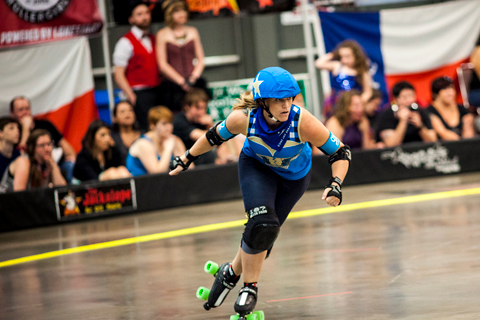Decoding Roller Derby

When roller derby made its comeback in 2000, there was little to go on by way of role models or game play rules. Undaunted by this challenge, the Austin grassroots league forged its own identity, including the creation of a set of rules based on the derby of yore—but with a few fun additions of their own.
After the infamous league split in 2003 and the creation of the Women’s Flat Track Derby Association (WFTDA) in 2004, the rules of the game evolved, greatly distinguishing Austin’s two leagues, the flat track (Texas Rollergirls, or TXRG) and banked track (Texas Roller Derby, TXRD), from one other.
Just how different can these two leagues be? What’s this banked track or flat track? Penalty wheels versus penalty boxes? How’s a new derby fan supposed to decode the game? Not to worry—Austin Fit Magazine is here with the Cliff Notes version so you can impress your friends at the next bout!
The Track
Roller derby can be played either on a flat track or a traditional banked track. In the early days of the sport’s renaissance, many leagues found banked tracks to be cost prohibitive and opted instead for the ease and availability of the flat track. Both track types offer their own excitement: Skating on a banked track requires special skill and speeds up the pace of the game; it is not uncommon for skaters to fly over the rail (a move that is practiced) after a hard hit. In contrast, the flat track allows fans to get up close and personal with the skaters—a spectator might end up with a rollergirl in his or her lap before the night is through.
The Kitsch
“Lucille Brawl,” “Tinkerhell,” “Cherry Chainsaw”…whether you play on a banked or flat track, one of the best parts of being a rollergirl is assuming an alter ego. Skaters register their names on an official roster, and it’s considered bad form to steal the name of another skater.
Each team on the league has a theme with corresponding uniforms, from Catholic schoolgirls (Holy Rollers and Hell Marys) to country cowgirls (Rhinestone Cowgirls and Honky Tonk Heartbreakers). Although derby uniforms have traditionally been risqué to downright raunchy (fishnet tights seem to be standard issue), many rollergirls over the years have transitioned to more practical garb as the level of athleticism has increased.
The Game
Although game play for TXRD and TXRG looks very different, the basic concept is the same. There are two teams, each of which has a “Jammer” (identified by the star on her helmet) who attempts to break through the pack of players and claim one point for each opposing team member she passes. Meanwhile, the pack members (“Blockers”) must do their best to assist their own Jammer and prevent the opposing team’s Jammer from getting through. While Jammers are traditionally known for being fast, all players must be light on their feet and able to think quickly and strategically.
Sanctioned Sport versus Sports Entertainment
TXRG operates according to WFTDA rules and sanctions; WFTDA is the international governing body of flat track roller derby and facilitates interleague play for its members. TXRG’s four regular teams play for their own yearly championship; additionally, there are two teams that represent TXRG in interleague match-ups—the Texecutioners (A team) and the Firing Squad (B team). TXRG is in close contention for the WFTDA championship each year.
TXRD is unaffiliated with any particular governing body and embraces its tradition of sports entertainment—spectators are guaranteed a good show. Although the league has its own travel team, the cost of obtaining space for and setup of a banked track hinders interleague bouts. Furthermore, since there is no official governing body of banked track leagues, compromises on rules and game play must often be arranged between leagues. TXRD’s own league championship—named for the late roller derby great Ann Calvello—is hotly contested each year and is the highlight of their season.
Penalty Box versus Penalty Wheel
There are many ways a rollergirl can earn herself a penalty, but TXRG and TXRD have very different methods of administering them.
Consistent with WFTDA regulations, TXRG skaters garnering penalties can ultimately earn themselves a trip to the penalty box, being taken out of game play.
Consistent with their model of sports entertainment, TXRD skaters garnering penalties can ultimately earn themselves a spin on the penalty wheel. Pillow fights, tug of war, a trip down spank alley…skaters are at the mercy of their Penalty Mistress for punishment.
What constitutes a penalty? A lot of things, and it varies greatly between leagues. Check out WFTDA’s official regulations regarding penalties and TXRD’s rules of the game.
Which League is More Fun to Watch?
Opinions are divided; the best way to answer this question is to attend the next TXRG and TXRD bout and decide for yourself!






